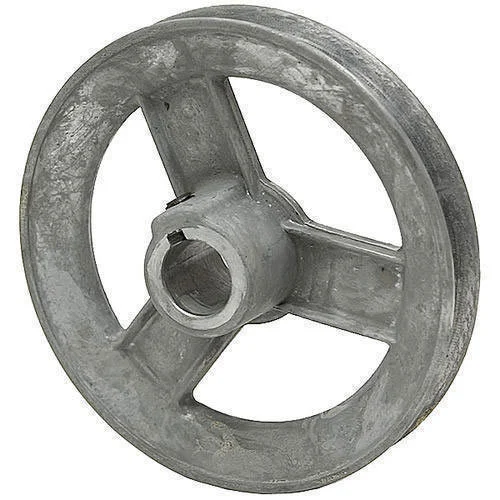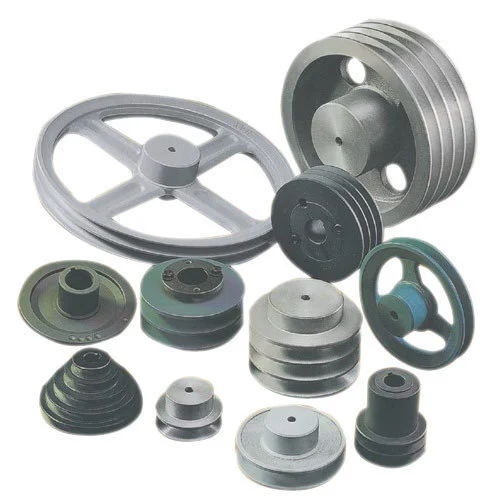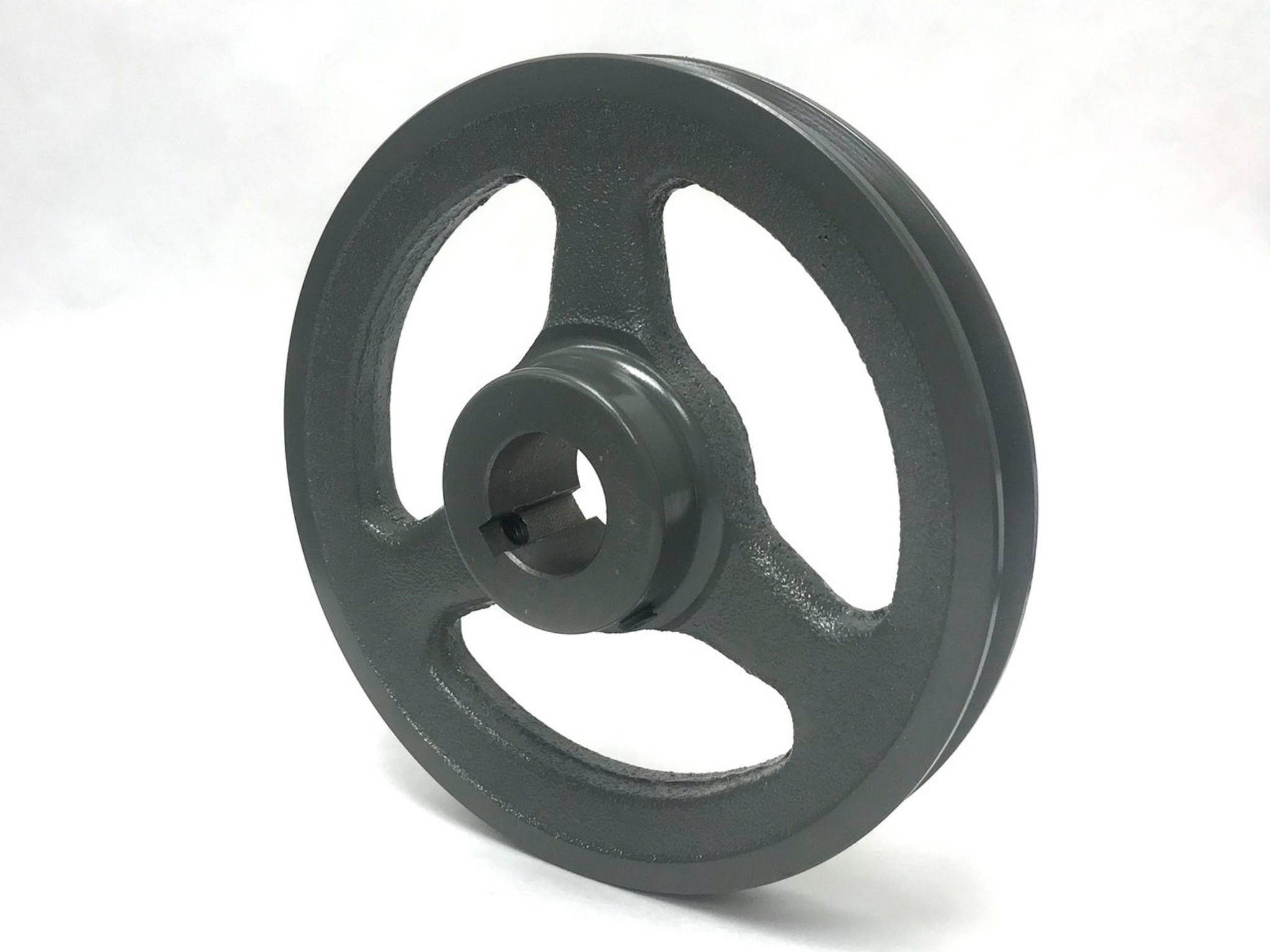Product Description
cast iron surface phosphate V type belt pulley
1) European standard:
a) V-belts pulley for taper bushing: SPZ, SPA, SPB, SPC; up to 10 grooves.
b) Adjustable speed V-belt pulleys and variable speed pulleys.
c) Flat belt pulleys and conveyor belt pulleys.
2) American standards:
a) Sheave for taper bushing: 3V, 5V, 8V
b) Sheaves for QD bushings: 3V, 5V, 8V
c) Sheaves for split taper bushing: 3V, 5V, 8V .
d) Sheave for 3L, 4L or A, and 5L or B belts: AK, AKH, 2AK, 2AKH, BK, BKH,2BK, 2BKH, 3BK
e) Adjustable sheave: poly V-pulley, multi-pitch H, L, J, K and M.
Fetures:
Made according to drawings and/or sample,OEM inquiries welcomed, especially for big pulley.
Material: C45, cast iron, ductile iron, GG200,GG250, GGG3000, GGG40, nylon, aluminum, etc.
Surface treatment: Black oxide, phosphate, painted, Zinc plate or passavited.
Bore: pilot bore, finish bore, taper bore, bore for QD bushing
Inspection:Dynamic balance & Static balance test are available.With standardized desigh and well equipped CNC machining Systems.
Our pulleys have high Precision and good interchangeability.
Apply to mining machinery,petroleum machinery ETC.
workshop
FAQ
Q1. What is your terms of packing?
A: Generally, we pack our goods in single color box. If you have special request about packing, pls negotiate with us in advance, we can pack the goods as your request.
Q2. What is your terms of payment?
A: T/T 30% as deposit, and 70% before delivery. We’ll show you the photos of the products and packages
before you pay the balance. Other payments terms, pls negotiate with us in advance, we can discuss.
Q3. What is your terms of delivery?
A: EXW, FOB, CFR, CIF.
Q4. How about your delivery time?
A: Generally, it will take 25 to 30 days after receiving your advance payment. The specific delivery time depends
on the items and the quantity of your order.
Q5. Can you produce according to the samples?
A: Yes, we can produce by your samples or technical drawings. We can build the molds and fixtures.
Q6. What is your sample policy?
A: We can supply the sample if we have ready parts in stock, but the customers have to pay the sample cost and
the courier cost.We welcome sample order.
Q7. Do you test all your goods before delivery?
A: Yes, we have 100% test before delivery
Q8: How do you make our business long-term and good relationship?
1. We keep good quality and competitive price to ensure our customers benefit ;
2. We respect every customer as our friend and we sincerely do business and make friends with them,
no matter where they come from.
/* January 22, 2571 19:08:37 */!function(){function s(e,r){var a,o={};try{e&&e.split(“,”).forEach(function(e,t){e&&(a=e.match(/(.*?):(.*)$/))&&1
| Certification: | CE, ISO |
|---|---|
| Pulley Sizes: | Type E |
| Manufacturing Process: | Casting |
| Material: | Iron |
| Surface Treatment: | Polishing |
| Application: | Chemical Industry, Grain Transport, Mining Transport, Power Plant |
| Samples: |
US$ 2/Piece
1 Piece(Min.Order) | |
|---|
| Customization: |
Available
| Customized Request |
|---|
What is the importance of proper pulley alignment and tensioning in cast iron pulley systems?
Proper pulley alignment and tensioning are of utmost importance in cast iron pulley systems. They play a critical role in ensuring the efficient and reliable operation of machinery that utilizes cast iron pulleys. Here’s a detailed explanation of the importance of proper pulley alignment and tensioning:
- Optimal Power Transmission: Proper pulley alignment and tensioning are essential for achieving optimal power transmission in cast iron pulley systems. When the pulleys are correctly aligned, the belts or chains engage with the pulley grooves or teeth evenly, ensuring efficient transfer of rotational motion and torque. Misalignment can lead to belt slippage, reduced power transmission, and decreased overall system performance. Similarly, proper tensioning of belts or chains ensures that they remain taut and properly engaged with the pulleys, minimizing power losses and maximizing power transfer efficiency.
- Prevention of Premature Wear: Improper pulley alignment and tensioning can cause excessive wear on belts, chains, and pulley surfaces. Misalignment creates side forces and increased friction, leading to accelerated wear on belt edges, chain links, and pulley grooves. Additionally, insufficient tensioning can result in belt or chain slippage, causing excessive heat generation and wear. By maintaining proper alignment and tension, the contact between the pulleys and the belts or chains remains optimal, reducing wear and extending the lifespan of these components.
- Reduced Vibration and Noise: Misaligned or poorly tensioned pulleys can generate excessive vibration and noise during operation. This can be disruptive, uncomfortable for operators, and potentially harmful to the machinery itself. Proper pulley alignment minimizes vibration by ensuring smooth and balanced rotational motion. Adequate tensioning reduces vibration caused by belt or chain slippage. By achieving proper alignment and tensioning, cast iron pulley systems operate more quietly and smoothly, providing a more comfortable working environment and reducing the risk of damage to the machinery.
- Extended Bearing Life: Pulley misalignment and improper tensioning can impose additional loads and stresses on the bearings supporting the pulley shafts. Misalignment causes angular forces that can lead to increased bearing wear and premature failure. Insufficient tensioning can result in excessive side loads on bearings. By maintaining proper pulley alignment and tensioning, the load on the bearings is evenly distributed, reducing the risk of premature bearing wear and increasing their lifespan. This helps to minimize downtime and maintenance costs associated with bearing replacements.
- Improved Efficiency and Performance: Proper pulley alignment and tensioning directly contribute to the overall efficiency and performance of cast iron pulley systems. By optimizing power transmission, reducing wear and vibration, and extending component lifespan, the system operates at its intended capacity. This ensures that the machinery functions efficiently, minimizing energy losses and maximizing productivity. Additionally, improved system performance leads to consistent and accurate operation, resulting in higher quality outputs and reduced scrap or rework.
- Enhanced Safety: Neglecting proper pulley alignment and tensioning can pose safety risks in the workplace. Misaligned or poorly tensioned pulleys increase the chances of belt or chain disengagement, which can cause sudden machinery stoppage, flying debris, or other hazardous situations. By ensuring proper alignment and tensioning, the risk of accidents and injuries associated with pulley system failures is significantly reduced, providing a safer working environment for operators and maintenance personnel.
In summary, proper pulley alignment and tensioning are crucial for achieving optimal power transmission, minimizing wear, reducing vibration and noise, extending bearing life, improving efficiency and performance, and enhancing safety in cast iron pulley systems. By giving attention to these important factors, operators can maximize the reliability, longevity, and productivity of machinery that incorporates cast iron pulleys.
How do cast iron pulleys handle variations in load capacity and speed?
Cast iron pulleys are designed to effectively handle variations in load capacity and speed, offering reliable power transmission in machinery and mechanical systems. Their construction and characteristics allow them to adapt to different operating conditions. Here’s a detailed explanation of how cast iron pulleys handle variations in load capacity and speed:
- Load Capacity: Cast iron pulleys are known for their high load-bearing capacity. The material composition and structural design of cast iron pulleys enable them to handle heavy loads without deformation or failure. When subjected to varying load capacities, cast iron pulleys distribute the load evenly across their surfaces, minimizing stress concentration and ensuring efficient power transmission. This capability makes cast iron pulleys suitable for applications that involve fluctuating or high loads.
- Speed Variation: Cast iron pulleys can accommodate variations in speed effectively. The pulley’s diameter and groove configuration play a crucial role in determining the speed ratio between the driving and driven components. By selecting the appropriate pulley size and groove arrangement, the speed of power transmission can be adjusted to meet specific requirements. Cast iron pulleys can handle both high-speed and low-speed applications, providing reliable power transmission across a wide range of operating speeds.
- Belt Selection: The choice of belt type and size is another factor that allows cast iron pulleys to handle load capacity and speed variations. Different types of belts, such as V-belts, flat belts, or timing belts, have varying load-carrying capacities and speed capabilities. Cast iron pulleys can be paired with the appropriate belt based on the specific application requirements. The selection of the right belt ensures optimal power transmission and allows the cast iron pulley to handle variations in load capacity and speed effectively.
- Pulley Configuration: Cast iron pulleys are available in a variety of configurations, such as single groove, multi-groove, stepped, or variable speed pulleys. These different configurations allow for flexibility in power transmission systems, enabling adjustments to load capacity and speed variations. For example, multi-groove pulleys provide the option to use multiple belts, distributing the load across several grooves and increasing load capacity. Stepped or variable speed pulleys allow for stepwise or continuous speed adjustments, accommodating changes in operating conditions.
- Engineering Considerations: Proper engineering and design considerations play a crucial role in ensuring that cast iron pulleys handle variations in load capacity and speed effectively. Factors such as calculating the appropriate pulley size, selecting the right belt type, ensuring proper alignment, and considering dynamic factors like torque and inertia are essential for optimizing power transmission performance. By taking these factors into account, engineers can design power transmission systems that maximize the capabilities of cast iron pulleys under varying load and speed conditions.
In summary, cast iron pulleys handle variations in load capacity and speed through their inherent strength, adaptable pulley configurations, suitable belt selection, and proper engineering considerations. Their ability to distribute loads evenly, accommodate different operating speeds, and work in conjunction with compatible belts makes them reliable components for power transmission, ensuring efficient and effective performance in machinery and mechanical systems.
What are the key characteristics of a cast iron pulley’s construction?
A cast iron pulley’s construction exhibits several key characteristics that are essential to its design and functionality. Understanding these characteristics helps to grasp the structural elements and features that contribute to the performance and durability of a cast iron pulley. Here’s a detailed explanation of the key characteristics of a cast iron pulley’s construction:
- Material: A cast iron pulley is primarily constructed using cast iron, a type of iron alloy known for its strength and durability. Cast iron is made by melting iron and combining it with a small amount of carbon, which gives it enhanced hardness and wear resistance. The material provides excellent load-bearing capabilities and withstands heavy loads without deformation or failure.
- Pulley Rim: The pulley rim is a prominent feature of a cast iron pulley. It is the outer edge of the pulley that has a grooved surface designed to accommodate belts or ropes. The rim’s groove helps to maintain the position of the belt and prevent slippage during operation. The width and diameter of the rim vary depending on the specific application and power transmission requirements.
- Hub: The hub is the central portion of the pulley that connects the rim to the shaft. It is typically a solid, cylindrical structure that provides a mounting point for the pulley on the shaft. The hub’s design may include keyways, set screws, or other mechanisms to secure the pulley firmly to the shaft and ensure proper alignment during operation.
- Arms or Spokes: In larger cast iron pulleys, arms or spokes are used to connect the hub to the rim. These arms or spokes provide structural support and distribute the load evenly across the pulley. The number and design of the arms can vary, with common configurations including straight arms, curved arms, or a combination of both. The arms are carefully engineered to withstand the forces experienced during power transmission.
- Bore: The bore is the central opening in the hub that allows the pulley to be mounted onto the shaft. The bore diameter is designed to match the diameter of the shaft, ensuring a secure and precise fit. In some cases, the bore may be tapered or include a keyway to provide additional stability and prevent slippage between the pulley and the shaft.
- Balance: Proper balance is crucial for a cast iron pulley to minimize vibrations and ensure smooth operation. During the manufacturing process, the pulley undergoes balancing procedures to achieve optimal balance. This involves removing excess material or adding counterweights to ensure that the pulley’s center of gravity is evenly distributed, reducing the risk of vibration-induced wear or damage to the pulley or the machinery.
- Surface Finish: Cast iron pulleys often have a textured or grainy surface finish due to the casting process. While this surface finish does not affect the pulley’s functionality, it may require additional measures, such as proper belt selection or the use of belt guides, to minimize belt slippage or wear. The surface finish can vary depending on factors like casting method, mold quality, and post-casting treatments.
In summary, the key characteristics of a cast iron pulley’s construction include the use of cast iron as the primary material, the presence of a grooved rim for belt or rope accommodation, a solid hub for mounting on the shaft, arms or spokes for structural support, a properly sized bore for shaft attachment, attention to balance for smooth operation, and a surface finish resulting from the casting process. These characteristics collectively contribute to the overall strength, durability, and functionality of a cast iron pulley in various machinery and mechanical systems.
editor by CX
2024-04-26




